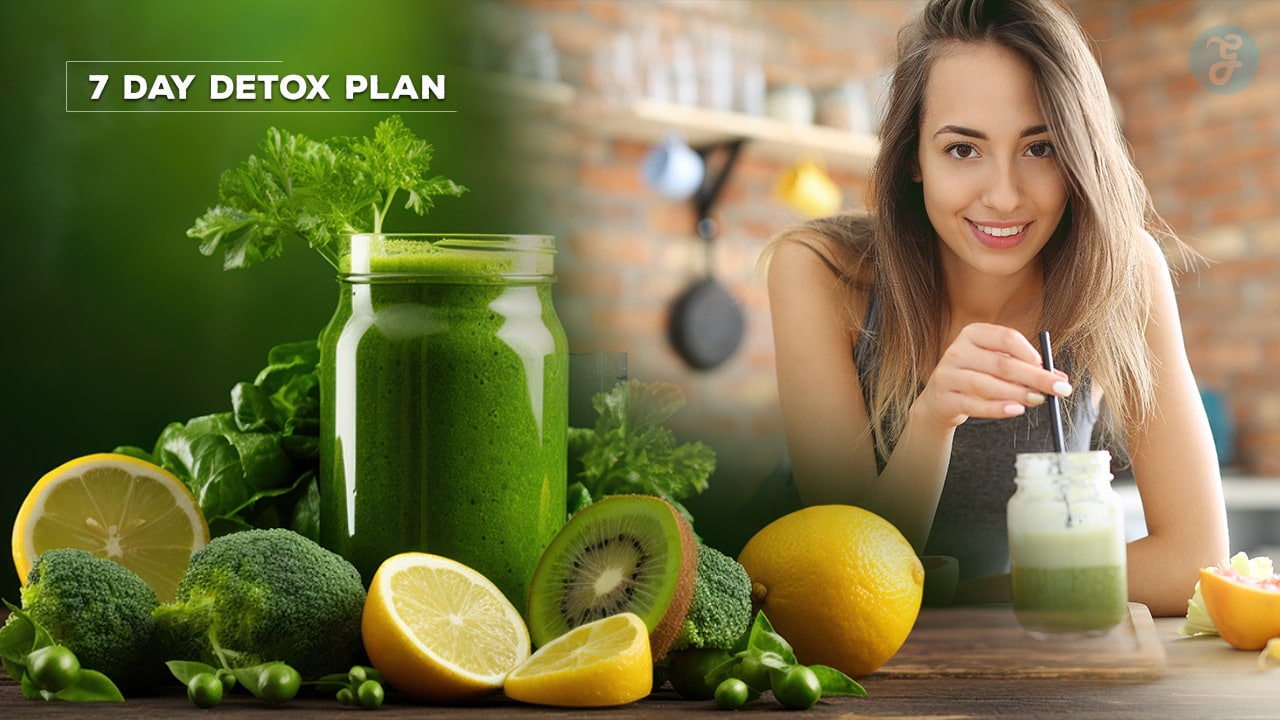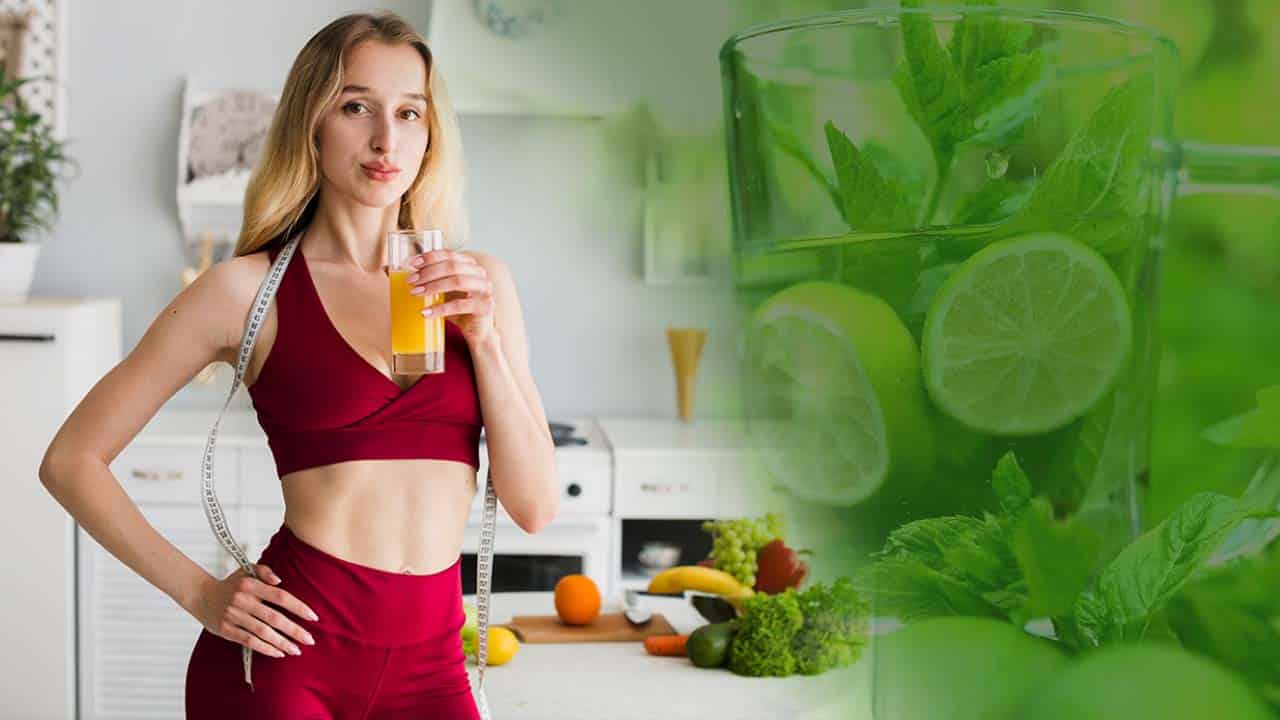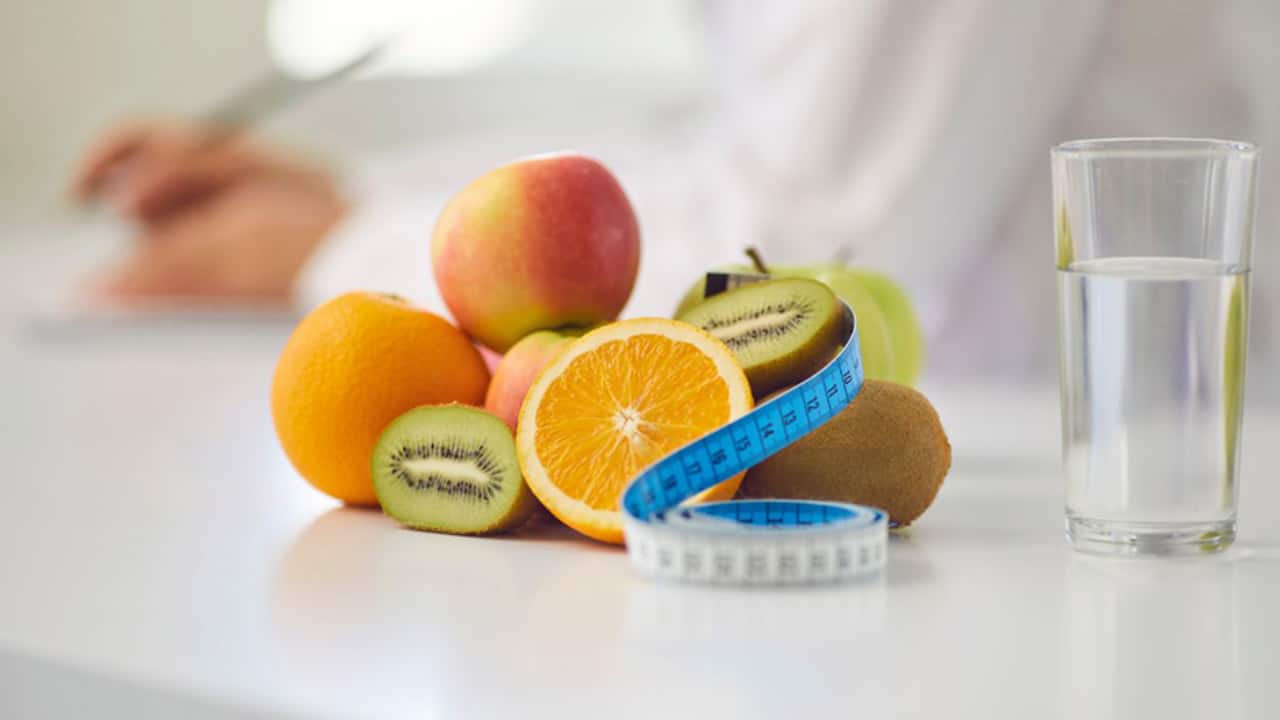In our modern world, we are constantly exposed to various toxins. These come from the air we breathe, the food we eat, and even the products we use on our skin. While our bodies have natural detoxification systems, the sheer volume of toxins we encounter daily overwhelms these processes. This is where a structured detox plan can be beneficial.
A 7-day detox plan supports and enhances your body’s natural detoxification processes. It’s not about starving yourself or relying on fancy juices and supplements.
Instead, it’s a thoughtful approach to nourishing your body with wholesome foods, staying hydrated, and engaging in practices that support overall health and well-being.
This comprehensive guide will walk you through a 7-day detox plan, explaining the science behind detoxification, the potential benefits, and how to implement this plan into your life safely. Remember, the goal is not just to “cleanse” for a week but to kickstart healthier habits that you can maintain long-term.
What is a Detox?
Detoxification is a natural process that your body performs constantly to neutralize, transform, and eliminate toxins. Toxins can be anything that potentially hurts body function.
They can be exogenous (external) toxins from the environment, such as pollutants, pesticides, and heavy metals, or endogenous (internal) toxins produced by normal metabolic processes in the body.
The primary organs involved in detoxification are:
- Liver: Often called the body’s filter, the liver processes toxins and turns them into less harmful substances that can be excreted.
- Kidneys: These organs filter blood and remove waste products through urine.
- Lungs: They expel gaseous waste products when we exhale.
- Skin: It eliminates certain toxins through sweat.
- Intestines: They remove solid waste and certain toxins through bowel movements.
A detox plan aims to reduce the intake of toxins while supporting and enhancing the function of these detoxification organs. This is typically done through dietary changes, increased hydration, and lifestyle modifications.
The Science of Detoxification
To understand how a detox plan works, diving deeper into the science of detoxification, mainly focusing on liver function, is helpful.
The liver’s detoxification process occurs in two phases:
- Phase I (Functionalization): In this phase, cytochrome P450 oxidases add a reactive or polar group to a toxin. This is the liver’s way of “tagging” the toxin for further processing.
- Phase II (Conjugation): Here, the liver cells add another substance (like glutathione) to the toxin, making it water-soluble. This allows the toxin to be excreted through urine or bile.
Certain nutrients are crucial for these processes:
- B vitamins, flavonoids, and glutathione are essential for Phase I.
- Amino acids, glutathione, and sulfur compounds support Phase II.
A well-designed detox plan ensures an adequate supply of these nutrients to support liver function.
Benefits of a 7-Day Detox Plan
While individual experiences may vary, many people report several benefits from completing a 7-day detox plan:
1. Improved Digestion:
By eliminating processed foods and focusing on whole, nutrient-dense options, many people experience better digestion and reduced bloating.
2. Increased Energy Levels:
As your body efficiently processes nutrients and eliminates toxins, you may feel more energetic.
3. Better Sleep Quality:
Reducing caffeine and alcohol intake and a nutrient-rich diet often improve sleep.
4. Clearer Skin:
Proper hydration and a diet of antioxidants can contribute to more precise, radiant skin.
5. Weight Loss:
While not the primary goal, some people may experience slight weight loss due to reduced calorie intake and elimination of processed foods.
6. Reduced Inflammation:
A diet high in anti-inflammatory foods can help reduce overall body inflammation.
7. Enhanced Mental Clarity:
Many people report feeling more focused and clear-headed during and after a detox.
8. More muscular Immune System:
Nutrient-dense foods can help support immune function.
9. Reset Eating Habits:
A structured detox can help break unhealthy eating patterns and cravings.
10. Increased Body Awareness:
Paying close attention to what you eat and how it affects you can increase overall body awareness.
It’s important to note that while many people report these benefits, scientific evidence for some of these claims is limited. The effects can vary significantly from person to person, and long-term healthy lifestyle choices for lasting effects should support any benefits experienced during a short-term detox.
Preparing for Your 7-Day Detox
Proper preparation is critical to a successful and enjoyable detox experience. Here’s an expanded guide on how to prepare:
1. Gradual Reduction:
In the week following your detox, gradually reduce your intake of caffeine, alcohol, processed foods, and refined sugars. This can help minimize potential withdrawal symptoms during the detox.
2. Mental Preparation:
Set clear intentions for your detox. Are you looking to break unhealthy habits? Increase your energy? Improve your digestion? Having clear goals can motivate you throughout the week.
3. Meal Planning:
Plan your meals for the week in advance. This helps ensure you have all the necessary ingredients and reduces the temptation to stray from the plan.
4. Grocery Shopping:
Stock on fresh fruits, vegetables, lean proteins, whole grains, and herbs. Choose organic produce when possible to minimize pesticide exposure.
5. Kitchen Prep:
Clear out tempting, non-detox-friendly foods from your pantry and fridge. Prepare some meals or snacks in advance if your schedule is busy.
6. Hydration Station:
Invest in a good water bottle and perhaps some herbal teas you enjoy. Staying hydrated will be crucial during your detox.
7. Schedule Adjustments:
Try to lighten your schedule during the detox week. This can reduce stress and allow you to focus on self-care.
8. Sleep Routine:
Establish a consistent sleep routine on the days leading up to detox. Aim for 7-9 hours of sleep per night.
9. Exercise Plan:
Plan some gentle exercises for the week. Walking, yoga, or light swimming can be great options.
10. Support System:
Let your family or friends know about your plan. Having support can make the process easier and more enjoyable.
11. Journaling:
Consider keeping a journal during detox to track your food intake, energy levels, and any changes you notice.
12. Stress Management:
Plan stress-reducing activities like meditation, deep breathing exercises, or gentle stretching.
Remember, the goal is to set yourself up for success. By preparing thoroughly, you’ll be more likely to stick to your plan and enjoy the process.
The 7-Day Detox Plan
Now, let’s dive into a detailed day-by-day plan for your 7-day detox. Remember, this is a general guide and can be adjusted based on your needs and preferences. Always listen to your body and consult a healthcare professional with any concerns.
Day 1: Kickstart Your Detox
Theme: Gentle Introduction
1. Upon Waking:
Start your day with warm water and freshly squeezed lemon juice. This helps stimulate digestion and liver function.
2. Morning Routine:
- 10-minute gentle stretching or yoga
- 5-minute meditation or deep breathing exercises
3. Breakfast (8-9 AM):
Green Detox Smoothie
- Blend 1 cup spinach, one banana, 1/2 green apple, 1 tbsp chia seeds, one scoop plant-based protein powder, and 1 cup unsweetened almond milk.
- Hydration: Herbal tea (green tea or peppermint)
4. Mid-Morning Snack (if needed):
One small pear with ten raw almonds
Lunch (12-1 PM): Rainbow Detox Salad
- Base: Mixed greens (spinach, arugula, kale)
- Toppings: 1/4 avocado, 1/2 cup cherry tomatoes, 1/4 cucumber, 1/4 cup shredded carrots, 1/4 cup chickpeas
- Dressing: 1 tbsp extra virgin olive oil, 1 tbsp lemon juice, herbs (basil, parsley)
- Hydration: Water with cucumber slices
5. Afternoon Snack (3-4 PM):
Celery sticks with 2 tbsp hummus.
Dinner (6-7 PM): Steamed Vegetable Medley with Quinoa
- 1 cup mixed steamed vegetables (broccoli, cauliflower, carrots)
- 1/2 cup cooked quinoa
- 3 oz grilled chicken breast or tofu
- Seasoning: Lemon juice, garlic, and herbs
- Hydration: Chamomile tea
6. Evening Routine:
- A 20-minute walk after dinner
- Relaxing activity (reading, gentle stretching, or meditation)
7. Before Bed:
1 cup of caffeine-free herbal tea (e.g., chamomile or lavender)
Hydration Goal: Aim for 8-10 glasses of water throughout the day
Day 2: Focus on Hydration
Theme: Flushing Out Toxins
1. Upon Waking:
Warm lemon water
2. Morning Routine:
- 15-minute yoga or gentle exercises
- 10-minute meditation
3. Breakfast (8-9 AM):
Chia Seed Pudding
- Mix: 3 tbsp chia seeds, 1 cup unsweetened almond milk, 1 tsp vanilla extract
- Topping: 1/2 cup mixed berries, 1 tbsp unsweetened coconut flakes
- Hydration: Green tea
4. Mid-Morning Snack (if needed):
One small apple with 1 tbsp almond butter
5. Lunch (12-1 PM):
Detox Vegetable Soup
- Ingredients: Low-sodium vegetable broth, mixed vegetables (carrots, celery, onions, tomatoes, spinach), herbs (thyme, parsley)
- Side: 1/4 cup mixed raw nuts
- Hydration: Water with lemon slices
6. Afternoon Snack (3-4 PM):
1 cup mixed berries
7. Dinner (6-7 PM):
Baked Sweet Potato with Steamed Greens
- One medium-baked sweet potato
- 1 cup steamed kale or Swiss chard
- 3 oz grilled or baked fish (salmon, cod, or trout)
- Seasoning: Lemon juice, dill
- Hydration: Peppermint tea
8. Evening Routine:
- 30-minute walk or light exercise
- Epsom salt bath for relaxation and detoxification
9. Before Bed:
1 cup of caffeine-free herbal tea
Hydration Goal: Increase to 10-12 glasses of water today
Day 3: Boost Your Fiber Intake
Theme: Supporting Digestive Health
1. Upon Waking:
Warm lemon water with a pinch of cayenne pepper
2. Morning Routine:
- 20-minute brisk walk or jog
- 5-minute deep breathing exercises
3. Breakfast (8-9 AM):
Fiber-Rich Oatmeal Bowl
- 1/2 cup rolled oats cooked in water
- Toppings: 1 sliced apple, 1 tbsp ground flaxseeds, 1 tsp cinnamon
- Hydration: Dandelion root tea
4. Mid-Morning Snack (if needed):
One small handful of raw almonds and one tangerine
5. Lunch (12-1 PM):
Lentil and Brown Rice Bowl
- 1/2 cup cooked brown rice
- 1/2 cup cooked lentils
- 1 cup steamed mixed vegetables (broccoli, carrots, snap peas)
- Dressing: 1 tbsp olive oil, lemon juice, herbs
- Hydration: Water with cucumber and mint
6. Afternoon Snack (3-4 PM):
1 cup raw vegetables (carrots, cucumber, bell peppers) with 2 tbsp guacamole
7. Dinner (6-7 PM):
Large Mixed Green Salad
- Base: Mixed greens (spinach, arugula, romaine)
- Toppings: 1/4 avocado, 1/4 cup chickpeas, 1/4 cup cherry tomatoes, 1/4 cucumber, 2 tbsp pumpkin seeds
- Protein: 3 oz grilled chicken or tempeh
- Dressing: 1 tbsp apple cider vinegar, 1 tsp olive oil, herbs
- Hydration: Fennel tea
8. Evening Routine:
- 15-minute gentle yoga or stretching
- Journaling or meditation
9. Before Bed:
1 cup of caffeine-free herbal tea (e.g., chamomile or valerian root)
Hydration Goal: Maintain 10-12 glasses of water
Day 4: Introduce Probiotic Foods
Theme: Gut Health
1. Upon Waking:
Warm lemon water with a small piece of grated ginger
2. Morning Routine:
- 20-minute yoga or Pilates
- 10-minute guided meditation
3. Breakfast (8-9 AM):
Probiotic Parfait
- 1/2 cup Greek yogurt (or dairy-free alternative)
- 1/4 cup mixed berries
- 1 tbsp chia seeds
- 1 tbsp pumpkin seeds
- Hydration: Green tea
4. Mid-Morning Snack (if needed):
One small pear with 1 tbsp almond butter
5. Lunch (12-1 PM):
Probiotic-Rich Veggie and Rice Bowl
- 1/2 cup brown rice
- 1 cup sautéed mixed vegetables (bell peppers, zucchini, mushrooms)
- 3 oz grilled tofu or chicken
- 2 tbsp kimchi or sauerkraut
- Dressing: 1 tsp sesame oil, 1 tsp rice vinegar
- Hydration: Kombucha (if tolerated) or water with lemon
6. Afternoon Snack (3-4 PM):
One small apple with 1 oz raw cheese (if tolerated) or 2 tbsp hummus
7. Dinner (6-7 PM):
Grilled Salmon with Roasted Vegetables
- 4 oz grilled salmon
- 1 cup roasted mixed vegetables (Brussels sprouts, sweet potato, red onion)
- 1/2 cup quinoa
- Seasoning: Lemon, dill, garlic
- Side: Small serving of fermented vegetables (e.g., pickles or kimchi)
- Hydration: Ginger tea
8. Evening Routine:
- 30-minute walk
- Relaxing activity (reading, listening to calming music)
9. Before Bed:
1 cup of kefir (if tolerated) or caffeine-free herbal tea
Hydration Goal: Aim for 8-10 glasses of water, in addition to probiotic drinks
Day 5: Focus on Antioxidants
Theme: Cellular Health and Protection
1. Upon Waking:
Warm lemon water with a dash of turmeric
2. Morning Routine:
- 25-minute moderate-intensity exercise (brisk walking, cycling, or swimming)
- 5-minute gratitude journaling
3. Breakfast (8-9 AM):
Antioxidant-Rich Acai Bowl
- Base: 1 frozen acai packet blended with 1/2 banana and 1/4 cup unsweetened almond milk
- Toppings: 1/4 cup mixed berries (blueberries, strawberries, raspberries), 1 tbsp goji berries, 1 tbsp hemp seeds, 1 tsp bee pollen (optional)
- Hydration: Green tea or matcha latte made with unsweetened almond milk
4. Mid-Morning Snack (if needed):
One small handful of mixed raw nuts (almonds, walnuts, pecans) and one kiwi fruit
5. Lunch (12-1 PM):
Antioxidant Power Salad
- Base: 2 cups mixed dark leafy greens (spinach, kale, arugula)
- Protein: 3 oz grilled chicken breast or tempeh
- Toppings: 1/4 cup pomegranate seeds, 1/4 avocado, 1/4 cup cherry tomatoes, 2 tbsp pumpkin seeds
- Dressing: 1 tbsp extra virgin olive oil, 1 tsp balsamic vinegar, 1 tsp Dijon mustard
- Side: 1 small sweet potato, roasted with skin on
- Hydration: Hibiscus tea (served iced or hot)
6. Afternoon Snack (3-4 PM):
Antioxidant Smoothie
- Blend: 1 cup mixed berries, one handful spinach, 1/2 cup unsweetened almond milk, 1 tsp spirulina powder, 1 tsp chia seeds
7. Dinner (6-7 PM):
Herb-Crusted Baked Cod with Roasted Vegetables
- 4 oz baked cod with an herb crust (parsley, basil, oregano)
- 1 cup roasted mixed vegetables (Brussels sprouts, bell peppers, red onions)
- 1/2 cup quinoa cooked in low-sodium vegetable broth
- Seasoning: Garlic, lemon zest, black pepper
- Side: Small mixed green salad with 1 tsp olive oil and lemon juice dressing
- Hydration: Rooibos tea
8. Evening Routine:
- 20-minute gentle yoga or stretching focusing on relaxation
- 10-minute meditation or deep breathing exercises
9. Before Bed:
1 cup of caffeine-free herbal tea (e.g., chamomile, lavender, or passionflower)
10. Evening Snack (if needed):
One small square of dark chocolate (70% cocoa or higher)
Hydration Goal: Aim for 8-10 glasses of water, in addition to antioxidant-rich teas
Notes for Day 5:
1. Antioxidant Focus:
Today’s meals are rich in various antioxidants, which help protect your cells from damage caused by free radicals. Essential antioxidants include vitamins C and E, beta-carotene, and polyphenols.
2. Color Variety:
Aim for various colorful fruits and vegetables throughout the day. Different colors often indicate multiple types of antioxidants.
3. Herbs and Spices:
Add antioxidant-rich herbs and spices like turmeric, cinnamon, ginger, and oregano to your meals.
4. Hydration:
Besides water, include antioxidant-rich teas like green tea, hibiscus tea, and rooibos tea.
5. Skin Care:
Consider using a natural, antioxidant-rich face mask (e.g., mashed avocado with a bit of honey) to nourish your skin from the outside.
6. Stress Management:
Practice stress-reduction techniques throughout the day, as stress can increase free radical production in the body.
7. Sleep:
Prioritize getting 7-9 hours of quality sleep tonight, as good sleep is crucial for your body’s natural detoxification processes.
Remember, while focusing on antioxidant-rich foods can be beneficial, the consistent, long-term inclusion of these foods in your diet provides the most significant health benefits. Use this day as inspiration for incorporating more antioxidant-rich foods into your regular eating habits beyond the detox week.
Day 6: Liver Support
Theme: Enhancing Liver Function
The liver is your body’s primary detoxification organ, so today, we’ll focus on foods and activities that support liver health.
1. Upon Waking:
Warm water with the juice of 1/2 lemon and a pinch of cayenne pepper
2. Morning Routine:
- 30-minute moderate exercise (e.g., brisk walking, cycling, or swimming)
- 10-minute liver support yoga sequence (including twists and forward bends)
3. Breakfast (8-9 AM):
Liver-Supporting Green Smoothie
- Blend 1 cup kale, 1/2 green apple, 1/2 lemon (peeled), 1-inch piece ginger, 1 tbsp flaxseeds, 1 cup unsweetened almond milk, 1/2 cup water.
- Optional: 1 scoop of plant-based protein powder
- Hydration: Dandelion root tea
4. Mid-Morning Snack (if needed):
One small pear with 1 tbsp raw, unsalted sunflower seeds
5. Lunch (12-1 PM):
Detox Lentil Soup
- Ingredients: 1/2 cup cooked lentils, 1 cup mixed vegetables (carrots, celery, onions, garlic), 1 cup low-sodium vegetable broth, 1 tsp turmeric, 1 tsp cumin
- Side: 1 cup mixed green salad with 1 tsp olive oil and lemon juice dressing
- Hydration: Water infused with cucumber and mint
6. Afternoon Snack (3-4 PM):
One small bunch of grapes and 1 oz raw, unsalted nuts (almonds or walnuts)
7. Dinner (6-7 PM):
Grilled Herb Turkey with Sautéed Greens
- 4 oz grilled turkey breast seasoned with rosemary and thyme
- 1 cup sautéed mixed greens (kale, spinach, and Swiss chard) with garlic and lemon
- 1/2 cup cooked quinoa
- Side: 1/2 cup steamed broccoli
- Hydration: Milk thistle tea
8. Evening Routine:
- 20-minute gentle walk
- Dry brushing before shower (to support lymphatic system)
- 10-minute meditation focusing on the liver area
9. Before Bed:
1 cup of caffeine-free chamomile tea
Hydration Goal: Aim for 10-12 glasses of water, focusing on staying well-hydrated to support the liver’s detoxification processes.
Notes for Day 6:
1. Liver-Supporting Foods:
Today’s meals include foods that support liver health, such as leafy greens, cruciferous vegetables, lentils, and herbs like turmeric and milk thistle.
2. Hydration:
Adequate hydration is crucial for liver function, so consciously drink water regularly throughout the day.
3. Avoid Toxins:
Be extra mindful today to avoid alcohol, processed foods, and excessive caffeine, which can burden the liver.
4. Stress Management:
Practice stress-reduction techniques, as chronic stress can impact liver function.
Day 7: Gentle Reintroduction
Theme: Transition and Reflection
On the final day of your detox, we’ll gently reintroduce some foods while maintaining the principles of clean eating.
1. Upon Waking:
Warm water with lemon
2. Morning Routine:
- 20-minute gentle yoga or stretching
- 10-minute journaling about your detox experience
3. Breakfast (8-9 AM):
Nourishing Breakfast Bowl
- Two soft-boiled eggs or 1/2 cup scrambled tofu
- One slice of whole-grain toast with 1/4 mashed avocado
- 1/2 cup sautéed spinach with garlic
- Hydration: Green tea or herbal tea of choice
4. Mid-Morning Snack (if needed):
One small apple with 1 tbsp almond butter
5. Lunch (12-1 PM):
Quinoa Veggie Bowl
- 1/2 cup cooked quinoa
- 1 cup roasted mixed vegetables (zucchini, bell peppers, carrots)
- 1/4 cup chickpeas
- 2 tbsp hummus
- Dressing: 1 tsp olive oil, lemon juice, and herbs
- Hydration: Water with a splash of unsweetened coconut water
6. Afternoon Snack (3-4 PM):
1 cup mixed berries with 1/4 cup unsweetened Greek yogurt (or plant-based alternative)
7. Dinner (6-7 PM):
Baked Salmon with Roasted Sweet Potato
- 4 oz baked salmon seasoned with dill and lemon
- One small roasted sweet potato
- 1 cup steamed mixed vegetables (broccoli, cauliflower, carrots)
- Side: Small mixed green salad with balsamic vinaigrette
- Hydration: Herbal tea of choice
8. Evening Routine:
- 30-minute leisurely walk
- Epsom salt bath for relaxation
- Reflection on the past week and setting intentions for moving forward
9. Before Bed:
1 cup of caffeine-free herbal tea (e.g., chamomile or lavender)
Hydration Goal: Maintain 8-10 glasses of water throughout the day.
Notes for Day 7:
1. Mindful Reintroduction:
As you reintroduce foods like whole grains and lean proteins, pay attention to how your body feels.
2. Portion Control:
Continue to be mindful of portion sizes as you transition back to a more varied diet.
3. Reflection:
Reflect on the changes you’ve experienced over the past week. What worked well for you? What challenges did you face?
4. Planning:
Consider incorporating healthy habits you’ve developed this week into your routine.
Post-Detox Maintenance
Completing a 7-day detox is an achievement, but the real challenge lies in maintaining the benefits long-term. Here are some strategies to help you transition back to your routine while keeping the spirit of your detox alive:
1. Gradual Reintroduction:
Slowly reintroduce foods you eliminated during the detox. This allows you to identify any foods that may not agree with you.
2. Maintain Hydration:
Continue to prioritize water intake. Aim for at least eight glasses of water daily.
3. Emphasize Whole Foods:
Make whole, unprocessed foods the foundation of your diet. Aim to fill half your plate with vegetables at each meal.
4. Mindful Eating:
Pay attention to hunger cues and practice eating without distractions.
5. Regular Exercise:
Incorporate regular physical activity into your routine. Find activities you enjoy to make exercise sustainable.
6. Stress Management:
Continue meditation, deep breathing, or yoga to manage stress.
7. Sleep Hygiene:
Prioritize getting 7-9 hours of sleep each night.
8. Periodic Mini-Detoxes:
Consider periodically incorporating a day of clean eating or a weekend detox to reset your system.
9. Listen to Your Body:
Pay attention to how different foods and lifestyle choices make you feel.
10. Sustainable Changes:
Focus on making small, sustainable changes rather than drastic shifts that are hard to maintain.
Potential Side Effects and How to Manage Them
While many people experience positive effects during a detox, some may encounter temporary discomfort as their body adjusts. Common side effects and management strategies include:
1. Headaches:
Often due to caffeine withdrawal. Stay hydrated and consider gradually reducing caffeine before the detox.
2. Fatigue:
Your body is adjusting to a new diet. Ensure you’re getting adequate rest and nutrients.
3. Digestive Issues:
Changes in diet can affect digestion. Stay hydrated and consider adding probiotic-rich foods.
4. Irritability:
Often temporary as your body adjusts. Practice stress-management techniques and ensure adequate sleep.
5. Skin Breakouts:
Sometimes, the skin purges toxins. Stay hydrated and practice good skincare.
If symptoms persist or worsen, consulting a healthcare professional is essential.
Is a 7-Day Detox Right for Everyone?
While many people can benefit from a gentle detox, it’s not suitable for everyone. Those who should avoid or modify a detox plan include:
- Pregnant or breastfeeding women
- People with chronic health conditions (e.g., diabetes, heart disease)
- Individuals with a history of eating disorders
- Children and teenagers
- Elderly individuals
- Anyone on medication (consult with a doctor first)
Always consult with a healthcare professional before starting any new diet or detox plan, especially if you have underlying health conditions.
Takeaways
A 7-day detox can be a valuable tool for resetting your eating habits, supporting your body’s natural detoxification processes, and kickstarting a healthier lifestyle. However, it’s important to remember that proper health comes from consistent, long-term habits rather than short-term fixes.
Use this detox plan as a springboard to develop sustainable healthy habits. Focus on nourishing your body with whole foods, staying hydrated, managing stress, and getting regular exercise and adequate sleep.
These lifestyle factors, practiced consistently over time, are crucial to supporting your body’s natural detoxification processes and promoting overall health and well-being.
Remember, everyone’s body is different. Listen to your body, be patient with yourself, and don’t hesitate to seek guidance from healthcare professionals as you navigate your health journey. Here’s to your health and vitality!














































